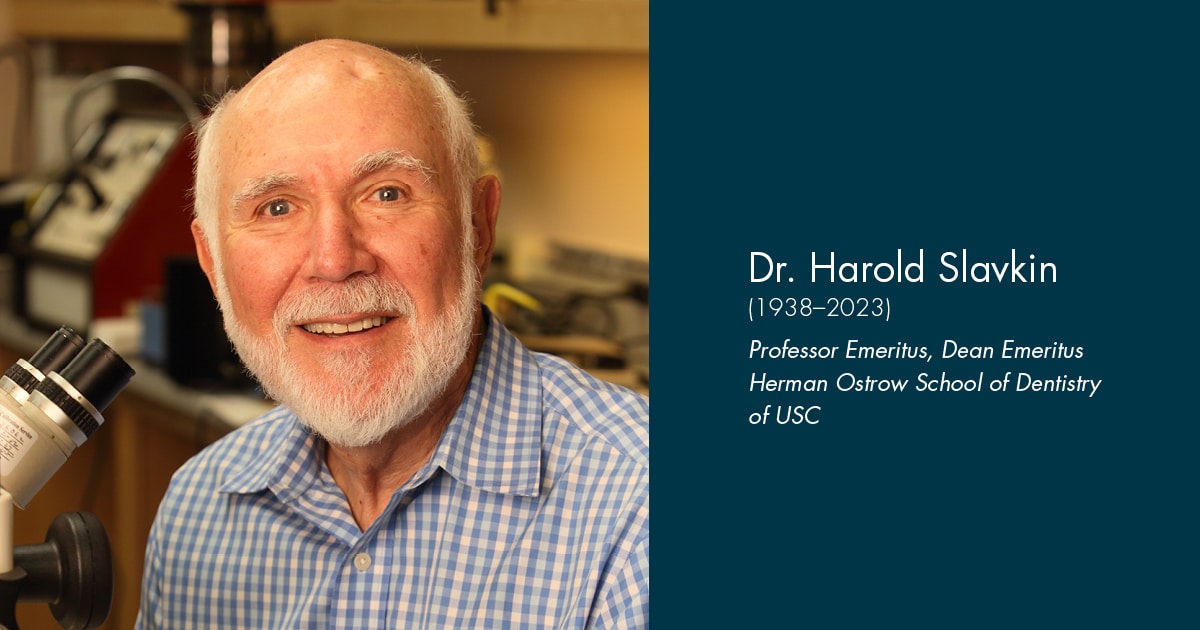Harold C. Slavkin, DDS, a leading authority on craniofacial biology, dean emeritus at the Herman Ostrow School of Dentistry of USC and a founding member of the nonprofit oral health think tank the Santa Fe Group, died Dec. 22, 2023, at his home in Marina Del Rey, California. He was 85.
Dr. Slavkin, who frequently went by the first name Hal, “lived a full life in service to others” and “was driven by a commitment to social justice and a passion to eliminate disparities in access to healthcare,” loved ones shared in an obituary.
Born in 1938 in Chicago, Illinois, Slavkin moved with his family to California at age 3, soon settling in Los Angeles. After graduating from Hamilton High School, Slavkin enlisted in the U.S. Army and completed training to become a dental lab technician. With the assistance of wages he earned through his newly acquired skills, he enrolled at the University of Southern California and graduated with a bachelor’s degree in English and Science in 1961 and a Doctor of Dental Surgery in 1965.
Developing a keen interest in biomedical scientific research, Slavkin continued his education as a postdoctoral fellow in cell/cellular biology and anatomical sciences at the University of California, Los Angeles, and completed a postdoctoral fellowship in biochemistry and developmental biology at the University of Southern California in 1968, launching his 46-year career at the university, as well as a lifetime of contributions to oral-craniofacial research and other scientific disciplines.
Slavkin created USC’s Center for Craniofacial Molecular Biology
In 1968, two years after earning his Doctor of Dental Surgery, Slavkin joined the dental faculty at USC, where he would teach for full time until his retirement in 2014.
During his nearly four decades at USC, he served as dean of the school of dentistry from 2000 and 2008 and in 1989 created the university’s Center for Craniofacial Molecular Biology, serving as its first director for six years. He also founded USC’s graduate program in craniofacial biology — the first program of its kind in the U.S. — and was a chairperson for student professional and ethical performance.
“His own passion for scientific inquiry was instrumental in sharpening Ostrow’s laser focus on research,” Ostrow School of Dentistry Dean Avishai Sadan wrote in a memorandum to the university’s dentistry community. “It is because of his leadership and forward-thinking that today the Herman Ostrow School of Dentistry of USC is the third highest-funded school by the National Institute of Dental and Craniofacial Research, one of the National Institutes of Health.”
First Surgeon General’s Report on oral health released under Slavkin’s leadership
Slavkin served as director of the National Institute of Dental and Craniofacial Research from 1995 to 2000 where, under his leadership, the institute created the first Surgeon General’s Report on oral health, “Oral Health in America,” released in May 2000.
During his tenure at NIDCR, he created one of the first strategic plans at National Institutes of Health to reduce racial and ethnic health disparities, including for conditions such as childhood caries and oral cancer. He developed a patient advocates forum, chaired the National Institutes of Health-wide committee for recruiting a diverse biomedical and behavioral research workforce and shared the institute’s research advances with the biomedical community and the public through outreach to scientific journals and the media.
“Hal was a pioneer in craniofacial biology and contributed to its emergence as a multidisciplinary field,” the NIDCR and NIH directors wrote in a tribute. “Hal will be remembered as a brilliant orator who effectively communicated his passion for research, his deep commitment to training future generations, and his fierce advocacy for health equity.”
A founding member of the Santa Fe Group, recipient of numerous awards
Slavkin was a founding member of the Santa Fe Group, a nonprofit organization with a mission to improve lives through oral health using a multidisciplinary approach to research, partnerships and problem-solving. He was a member for over 27 years and until his death.
He additionally served as an elected board member of the Los Angeles Trust for Children’s Health Foundation for nearly 10 years, remaining an active member until his death, and was a member of the National Academy of Medicine and other national, international and state professional and scientific organizations.
His significant contributions to his field earned him 10 honorary degrees, including a Doctor of Science Honorary Degree from McGill University in Montreal, Canada, and the American Dental Association in 2009 awarded him the Gold Medal Award for Excellence in Dental Research.
Slavkin authored and co-authored hundreds of publications, including “A Model for Interprofessional Health Care: Lessons Learned from Craniofacial Teams” published in the September 2014 issue of the Journal of the California Dental Association, and “Interactions Between BMP-7 and USAG-1 Regulate Supernumerary Organ Formations” published in PLOS ONE.
He is survived by his wife of 43 years, Lois, his sister, two sons, two stepchildren, eight grandchildren and three great grandsons.

